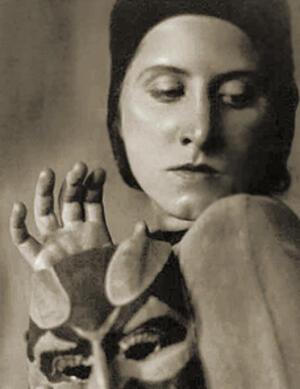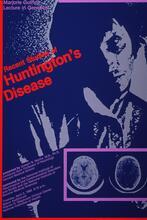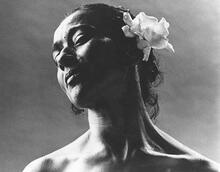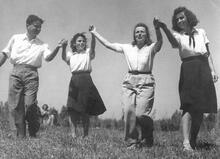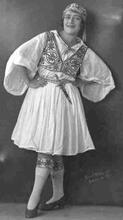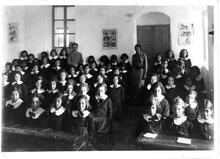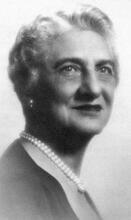Hilde Holger
Holger studied at the Academy for Music and the Performing Arts in Vienna and at age sixteen, she became the assistant of modern-dance pioneer Gertrud Bodenwieser and helped her mentor establish the Bodenwieser Group. In 1926 she established the New School for Movement Art, where she created numerous Jewish and political dance works. In 1939 she fled Vienna for Bombay, where she worked as a masseuse and solo dancer before becoming a dance school director in 1945. In 1948, disturbed by growing tensions between Hindus and Muslims, she moved to London. There, in 1951, she created Under the Sea, a work performed in a church that generated debate about the use of churches as performance spaces. When her son was born with Down syndrome, she began teaching dance to people with the same disability. She created almost 150 works and continued her career into her 90s.
Early Life and Dance Career
Water, fire and earth, the elements which reportedly occur as themes in Hilde Holger’s solo dances and choreography, fascinated her from the age of three, when she discovered the magic world of her grandfather’s garden. Born on October 18, 1905 in Vienna, she had been living in her grandparents’ home in the city’s suburb of Pötzleinsdorf from the time of her father’s death together with her mother and her sister, Heidi. Her parents were Alfred Sofer and Elise, née Schreiber.
Holger's encouraged the child’s imagination and joy in movement, so that in 1919, at the age of fourteen, she began studying with Gertrud Bodenwieser at the State Academy for Music and the Performing Arts in Vienna. Two years later she became Bodenwieser’s assistant and participated in establishing the Bodenwieser Group. In 1923 she gave her first solo recital in the House of the Vienna Secession movement. This was followed by performances in France, Poland and Czechoslovakia. In 1926 she left the Bodenwieser Group to establish her own dance school, the New School for Movement Art, in the baroque Vienna Palais Ratibor. In the period that followed she produced works with both political and Jewish themes: Wacht auf! (Wake Up!), a movement chorus in the framework of the Rote-Hilfe-Revue (1926), Four Pictures from the Time of the Paris Commune (1927), Hebräischer Tanz (Hebrew Dance, 1929), Kabbalistischer Tanz (1933) and Ahasuerus (1936).
India, England, and Family
In 1939 a friend helped Holger to emigrate to Bombay, where she lived for nine years, first working as a therapeutic masseuse (a profession she had acquired at the Rothschild Hospital in Vienna prior to emigrating), then as a solo dancer and from 1945 as the director of a school for dance. In 1946 she gave birth to a daughter, Primavera, with whom she moved to England in 1948, in the wake of her physician husband, Adi Boman-Behram. The religious strife between Hindus and Muslims and the subsequent massacres were unbearable for someone whose entire family had been massacred by the Germans.
In 1951 she had her London breakthrough with Under the Sea, based on a composition by Camille Saint-Saëns, which was first performed in the church of St. Martin-in-the-Fields. With her concept of using the altar steps as a stage, Hilde Holger consciously provoked a public discussion of the use of churches as theater space.
Dance and Disability
In 1949, Hilde Holger gave birth to her son Darius, who suffered from Down Syndrome. This led her to begin teaching dance to other young people with the same condition. A student of hers who attended one of these lessons was at first amazed to discover that when things did not go well Holger gave free rein to her temperament and scolded her pupils for their errors. On second thought, she realized that Holger was right in treating them just as she would “normal” students. This work led to Holger’s creating Towards the Light, to music by Edvard Grieg. First performed in 1969 at the Sadlers Wells Theater in London, the pioneering work introduced dance therapy to England.
Art and culture in the metropolis (Rockpaintings, 1975) and the processing of her experiences in India (Asparas, 1983) were the major themes of her works, which were performed primarily at the Hampstead Theatre and the Commonwealth Theatre. However, she “never abandoned her Vienna point of departure, as a philosophical place” (Hirschbach/Tavorian, 61).
Hilde Holger died in London on September 22, 2001.
Hirschbach, Denny, and Rick Tavorian. Die
Kraft des Tanzes. Hilde Holger: Wien-Bombay-London. On the Life and
Work of the Dancer, Choreographer and Dance Teacher. Bremen: 1990.
A detailed index of her works can be found on pages 82–89.
Archival material c/o Denny Hirschbach, verlag Zeichen und Spuren, Bremen.
Lexikon Jüdische Frauen. Edited by Jutta Dick and Marina Sassenberg.

